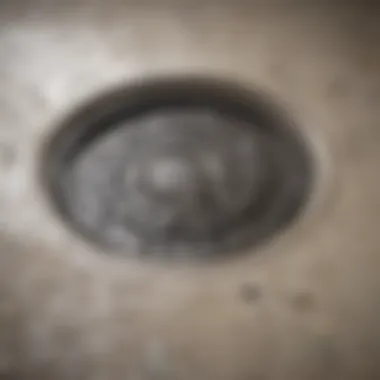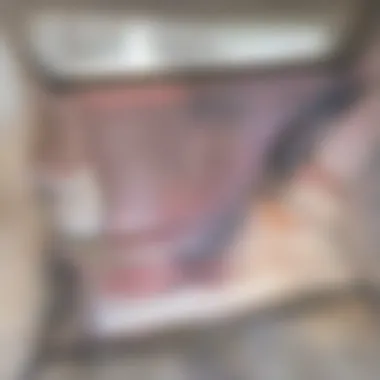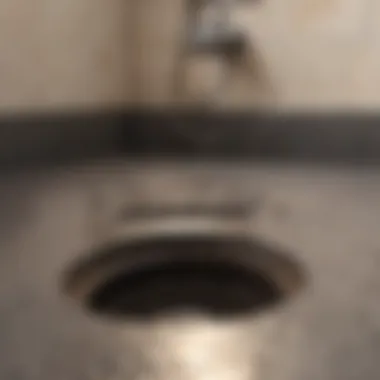Effective Solutions for Clogged Shower Drains


Intro
Clogged drains in showers are a significant nuisance that many individuals face in their daily lives. Understanding the underlying causes of these blockages is essential for maintaining a functional plumbing system. Over time, hair, soap residue, and mineral buildup can accumulate and restrict water flow, leading to irritation and potential water damage. Knowing how to approach and manage these situations is vital for any homeowner or renter.
This article seeks to illuminate the various aspects of clogged shower drains. We will discuss the common causes of these obstructions, provide effective do-it-yourself methods for clearing them, and highlight when it is necessary to call in a professional. In essence, this guide aims to equip readers with practical knowledge and strategies that will help them keep their plumbing in optimal condition.
Preamble
Clogged drains in showers are a pervasive concern that affects many homeowners and renters. Such blockages can lead to a range of inconveniences, from slow drainage to potential water damage. Recognizing the significance of this issue is essential. When showers do not drain properly, it can disrupt daily routines and create an unsanitary environment.
Understanding the underlying causes and implications of clogged drains is crucial for effective management. The goal of this article is to provide detailed insights into the factors that contribute to drain blockages and the remedies available. Moreover, understanding when to address these issues personally and when to involve professionals is important.
Maintaining a functional plumbing system is not only a matter of convenience but also one of health and safety. A clogged shower drain can lead to stagnant water, which may subsequently foster mold growth or attract pests. These challenges can result in unnecessary stress and unexpected costs.
By navigating through the structure of this article, readers will gain useful knowledge on identifying problems, applying DIY solutions, and recognizing the signs that professional assistance is required. In turn, this allows for better management of shower drains, reducing the likelihood of facing similar issues in the future. Ultimately, the aim is to equip the reader with practical tools and information to ensure their plumbing system operates smoothly.
Understanding Clogged Drains
Clogged drains in showers represent a significant challenge for homeowners and renters alike. A clear understanding of what causes these clogs, the symptoms that indicate their presence, and the underlying mechanics of drainage systems is crucial for managing this issue effectively. Knowledge in this area not only aids in preventing potential problems but can also foster a healthier and more efficient living environment.
What Constitutes a Clogged Drain
A clogged drain arises when the flow of water through the plumbing system is obstructed. This often occurs due to an accumulation of various debris, including hair, soap scum, and mineral deposits. More specifically, the structural design of shower drains typically means they can easily trap foreign materials, leading to a blockage when this debris builds up. Depending on the severity of the obstruction, water may drain slowly, or in extreme cases, not at all. Thus, it's essential to recognize that a clogged drain needs prompt attention to restore efficient drainage and avoid further complications.
Common Symptoms of Clogs
Identifying the signs of a clogged drain early can prevent a minor issue from evolving into a more significant problem. Common symptoms include:
- Slow drainage: Water taking longer to exit the shower can indicate a developing clog.
- Unpleasant odors: A foul smell emanating from the drain may signal organic materials decomposing.
- Gurgling noises: These sounds often suggest an obstruction in the drain line or air bubbles traveling through standing water.
- Pooling water: Water collecting around the shower floor while draining indicates a serious obstruction that likely requires remediation.
Being alert to these symptoms allows for timely intervention, reducing the risk of extensive damage.
How Drain Functionality Works
Understanding how drain systems operate can significantly assist in both prevention and resolution of clogs. Generally, a shower drain contains several components intended to facilitate water flow:
- Drain flange: The visible part of the drain where water exits. It contains small holes to catch water while preventing larger debris from falling through.
- P-Trap: This section holds a small amount of water to block sewer gases from entering the home, while still allowing wastewater to flow out.
- Waste pipe: After passing through the P-Trap, water travels down the waste pipe to either the home’s septic system or the municipal sewer line.
Understanding these components illustrates why it's essential to maintain clear drains. When any part of this system is obstructed, water cannot flow freely, leading to backlogs and potential overflowing. Regular inspection and maintenance of these features can prevent many common issues.
Causes of Clogs in Shower Drains
Understanding the causes of clogs in shower drains is crucial for effective management of this common household issue. Each factor contributing to these blockages can provide insights into prevention and remediation. Knowing the root causes is beneficial for homeowners aiming to maintain efficient plumbing systems. Additionally, this knowledge empowers individuals to tackle minor issues before they escalate into significant problems that may require professional intervention.
Accumulation of Hair
Hair is one of the primary culprits behind clogged shower drains. During showers, strands of hair are often washed down the drain. Over time, these strands can accumulate and form a dense mass that traps other debris, exacerbating the blockage. Long hair, in particular, tends to tangle easily, creating larger clogs. Regular removal of hair from the drain is necessary to prevent build-up. Placing a drain cover can also significantly reduce the amount of hair entering the drain, making routine maintenance more manageable.


Soap Residue Build-Up
The usage of soap in showers can lead to soap scum, a combination of soap and minerals from hard water. This residue can coat the insides of pipes over time and contribute to blockages. Soap residue creates a sticky layer that attracts dirt and hair, leading to a more severe clog. It is advisable to use liquid soaps, as they tend to create less residue compared to bar soaps. Regular cleaning of the drain can help mitigate the effects of soap scum.
Mineral Deposits and Hard Water
Hard water contains high levels of minerals like calcium and magnesium. When hard water flows through the pipes, these minerals can accumulate and form deposits over time. This build-up can reduce the diameter of the pipes, restricting water flow and leading to clogs. Homeowners experiencing frequent clogs might want to consider water softening systems to reduce mineral content. Additionally, periodic descaling of plumbing fixtures can prevent these deposits from causing significant plumbing issues.
Foreign Objects in the Drain
Foreign objects can also lead to blockages in shower drains. Items like shampoo caps, small toys, or even toiletries can inadvertently fall into the drain. Unlike hair or soap residue, these objects do not break down easily, causing immediate obstructions in water flow. Understanding the importance of being cautious with what goes down the drain is essential. Mindfully disposing of items may help in averting such problems. Regular checks can also catch potential blockages early.
Impact of Clogged Drains
Understanding the impact of clogged drains is crucial for homeowners and renters alike. Clogged drains can lead to a variety of problems that extend beyond mere inconvenience. Acknowledging these impacts helps in both preventive measures and quick responses when issues arise.
Reduced Drainage Efficiency
When a shower drain is clogged, water no longer flows freely. This reduced drainage efficiency can turn an ordinary shower into an unpleasant experience. Instead of water draining away, it accumulates in the shower, creating a pool that can disrupt your routine. This kept water not only causes discomfort but can also lead to higher water bills. If the drain is consistently slow, it may be a sign that a significant blockage has occurred, hinting at further plumbing problems if not addressed promptly.
Potential for Water Damage
One of the severe repercussions of a clogged shower drain is the potential for water damage. Standing water can seep into walls, flooring, and other structural components of your home. This can lead to mold growth, which poses both health risks and costly repairs. In certain scenarios, excess water can even result in structural weakening of the foundation. Thus, immediate action upon noticing a clog is essential to prevent further damage.
Health Risks from Standing Water
Standing water is not just a nuisance; it presents real health risks. Water that remains stagnant for an extended period becomes a breeding ground for bacteria, insects, and other pathogens. These can lead to undesirable health consequences for anyone in the household. Mold spores might take hold, exacerbating respiratory issues and allergies. Therefore, managing clogged drains with urgency is vital not only for the functionality of your plumbing system but also for safeguarding your health and well-being.
Clear awareness of these impacts can inform better habits regarding shower drain maintenance, ultimately leading to a healthier home environment.
In summary, the impact of clogged drains goes well beyond the immediate inconvenience. Reduced drainage efficiency, risks of water damage, and the health hazards posed by standing water combine to make this a critical issue to address. Engaging in preventive strategies can mitigate these risks and preserve the integrity of both your plumbing and your home.
DIY Methods for Clearing Clogs
Using a Plunger
The trusty plunger remains one of the simplest yet most efficient tools for unclogging a shower drain. To use it effectively, first ensure that excess water is below the overflow drain level. Position the cup of the plunger over the drain and apply firm pressure, creating a seal. Begin pumping up and down rapidly, then pull away sharply to release the clog.
This method is particularly beneficial because it requires no chemicals and is environmentally friendly. However, it may not be effective for very deep clogs or where blockages are compounded by foreign objects.
Employing Baking Soda and Vinegar
Another excellent method for clearing clogs utilizes baking soda and vinegar. This combination is quite effective due to the chemical reaction produced when they are mixed. Begin by pouring one cup of baking soda into the drain, followed by one cup of vinegar. The fizzing reaction can help dislodge and break down hair and soap residues.
Let the mixture sit for about 30 minutes, then flush the area with hot water. This method is gentle on pipes and is ideal for regular maintenance as well.
Manually Removing Debris
Sometimes, the best way to clear a clog is not through chemical means or tools but manual removal. Safely access the drain area by removing the drain cover. Using a pair of gloves, retrieve any visible debris such as hair or soap scum build-up. This hands-on approach allows you to clear the blockage and is essential for preventing future clogging.


Though it may seem unappealing, it is often the quickest way to restore drainage efficiency. This method also provides insight into the nature of the clogs you face, which can help in your preventative measures.
Utilizing a Drain Snake
A drain snake, or auger, is another tool frequently utilized in battling clogs. Insert the snake into the drain carefully, pushing through the blockage until resistance is met. Once the obstruction is at hand, either crank the snake to grip the debris or pull it back up to remove it. This method can be particularly advantageous when dealing with deep clogs that cannot be reached by a plunger or manual removal.
Using these DIY methods can significantly decrease the frequency of costly professional interventions while keeping plumbing systems in optimal condition.
Adopting a proactive approach to drains will result in a healthier plumbing system and more enjoyable showering experience. Regular application of these techniques can help maintain the flow in your shower, offering peace of mind when it comes to plumbing maintenance.
Preventative Measures
Preventative measures play a crucial role in maintaining clear shower drains. By adopting these practices, homeowners can avoid the frustration and cost associated with clogged drains. Effective measures not only enhance the efficiency of your plumbing system but also contribute to the longevity of fixtures in your home. Implementing routine checks and cleaning can offset many issues before they escalate into more significant problems.
Regular Cleaning Routines
Establishing a regular cleaning routine is essential for keeping shower drains clear. Schedule monthly inspections to remove any visible debris, such as hair or soap scum. Use a combination of hot water and mild cleaning agents to flush the drain periodically. This method helps dissolve residue buildup, which can cause future blockages. Additionally, consider using a drain brush to scrub unreachable areas of the drain.
Establishing a cleaning routine can include:
- Weekly rinsing of the drain with hot water.
- Monthly scrubbing of the drain cover and visible parts.
- Quarterly deep cleaning using enzyme-based cleaners designed for drains.
These steps can extend the time between more extensive cleaning efforts, saving both time and resources.
Using Drain Covers
Drain covers serve as a simple yet effective tool in preventing clogs. They act as a barrier, catching hair, soap shards, and other particles that may otherwise enter the plumbing system. Available in various sizes and styles, these covers can easily match your existing shower design. To maintain their effectiveness, regularly clean the covers to ensure they do not become overwhelmed with trapped debris.
Key benefits of using drain covers:
- Prevents hair and fibers from entering the drain.
- Easy to clean and reinstall.
- Cost-effective and widely available.
Incorporating this simple step into your shower routine can significantly reduce the likelihood of serious clogs.
Understanding Your Water Type
Different water types can affect the accumulation of minerals and residues in your plumbing. Knowing whether you have hard or soft water can help tailor your maintenance strategies accordingly. Hard water contains high levels of calcium and magnesium, which can lead to mineral deposits in your pipes over time. This buildup can alter the effectiveness of your cleaning methods.
To manage your specific water quality, consider these points:
- Test for hard water using commercial testing kits available at home improvement stores.
- Use descaling agents if hard water is present to prevent buildup.
- Adjust your cleaning frequency based on water quality to maintain optimal drain efficiency.
Understanding your water type allows you to make informed decisions about cleaning products and schedules, promoting a healthier plumbing system.
When to Call a Professional
Clogged drains in showers often lead to significant inconveniences, yet not all situations can be resolved through DIY methods. Recognizing when to consult a professional is critical in effectively managing clogged drains. Additionally, acting promptly can prevent complications that may escalate over time. This section delves into the telltale signs that indicate the need for a skilled plumber, along with the benefits of seeking professional assistance.
Identifying Persistent Issues


Certain symptoms may suggest that a clog is more than just a simple blockage. If the shower drain repeatedly backs up despite your best efforts to clear it, or if you notice slow drainage even after utilizing various methods, professional intervention may be necessary. These ongoing concerns can signal more significant plumbing issues, such as:
- Lead to water damage: Clogs can cause water to pool, which might harm your flooring and walls.
- Intensive blockages: If multiple drains in your home are slow or backing up at the same time, this could indicate a clog in the main sewer line.
It might also be worthwhile to examine the smell. An unpleasant odor may indicate trapped waste or sewage backing up into the drain, suggesting an urgent need for professional services.
Understanding the Scope of Damage
Assessing the extent of damage involves more than a visual check. If damp spots appear on walls or ceilings, or if mold develops around the drain area, it is time to bring in an expert. Mold can affect indoor air quality, posing health risks. Additionally, a plumber can provide a thorough inspection of the plumbing system to determine the underlying cause of blockages.
Plumbers often use specialized tools such as cameras to identify the nature and location of a clog, which you may not have at your disposal. This advanced technology allows for identifying:
- Hidden leaks: Small leaks that might contribute to clogs.
- Pipe deterioration: Old or damaged pipes can be a source of repeated problems.
- Root intrusion: Tree roots can infiltrate pipes, leading to serious blockage issues that typical home methods cannot address.
In summary, knowing when to engage professional help can save time and money. Ignoring the signs of persistent issues or failing to understand the potential damage to your plumbing system can exacerbate the situation significantly.
If in doubt, consulting a professional can provide peace of mind and ensure the health of your plumbing system.
Cost Implications of Clog Resolution
When dealing with clogged drains in showers, understanding the cost implications is crucial for homeowners and renters. Costs can vary significantly depending on whether the approach is DIY or professional. By assessing these options, one can better understand the financial impact on the home budget.
DIY vs. Professional Solutions
Taking a DIY approach often appeals to many people. The upfront costs can be lower since individuals can utilize household items or purchase inexpensive tools such as a plunger or a drain snake.
However, there are hidden costs to consider when choosing this method.
- Time and effort are significant. Those who lack experience may find themselves investing more time than anticipated to clear a clogged drain, which could be frustrating.
- If the clog persists, some methods might cause further damage, leading to more expensive repairs or professionals being needed in the end.
On the other hand, hiring a professional usually involves a higher initial expense. Technicians bring expertise and specialized tools that provide a quicker and more effective resolution to the problem.
- Professionals can diagnose issues that might not be visible to the average person, which enables better long-term management of the plumbing system.
- Ultimately, while DIY may save money short term, professional services can prevent deeper issues, ultimately saving costs in repairs.
Long-Term Financial Considerations
Understanding long-term financial implications goes beyond immediate costs. Maintaining a plumbing system reflects ongoing investments that can significantly impact home value.
- Regular maintenance, whether done through DIY methods or professionals, helps prevent severe issues from arising.
- Ignoring minor clogs can lead to larger problems such as broken pipes, water damage, or even mold, which can increase repair bills exponentially.
- Investing in preventive measures such as drain covers may incur minor costs but save money by significantly decreasing the frequency of clogs.
"A stitch in time saves nine."
By making informed decisions about how to manage clogged drains, one not only addresses immediate concerns but also makes a long-term commitment to protecting their property. Ultimately, understanding the cost implications of clog resolution can empower homeowners to make better choices and maintain their plumbing efficiently.
Concluding Thoughts
The issue of clogged shower drains is more than just a mere inconvenience. It represents a common challenge faced by many homeowners and tenants. In this article, we have explored the various aspects of clogged drains that can help individuals manage this problem effectively.
Understanding the causes of clogs, from hair and soap residue to foreign objects, allows for better preparation. This knowledge not only helps in addressing current issues but also plays a crucial role in preventing future blockages.
DIY methods for resolving clogs empower individuals to take action without reaching for a plumber on every occasion. Recognizing the time when to call a professional ensures that more severe issues are handled promptly and effectively. This can ultimately save time, money, and stress.
The cost implications discussed provide valuable insights for homeowners aiming to balance emergency fixes with long-term savings. Investing in preventative measures can mitigate the likelihood of future clogs, leading to more efficient plumbing systems and satisfied users.
To sum up, the management of clogged drains in showers necessitates a thorough understanding, practical approaches, and timely interventions. By prioritizing regular maintenance and recognizing the importance of prompt action, individuals can significantly enhance the reliability of their plumbing systems. This not only offers peace of mind but also safeguards the overall integrity of the home.















